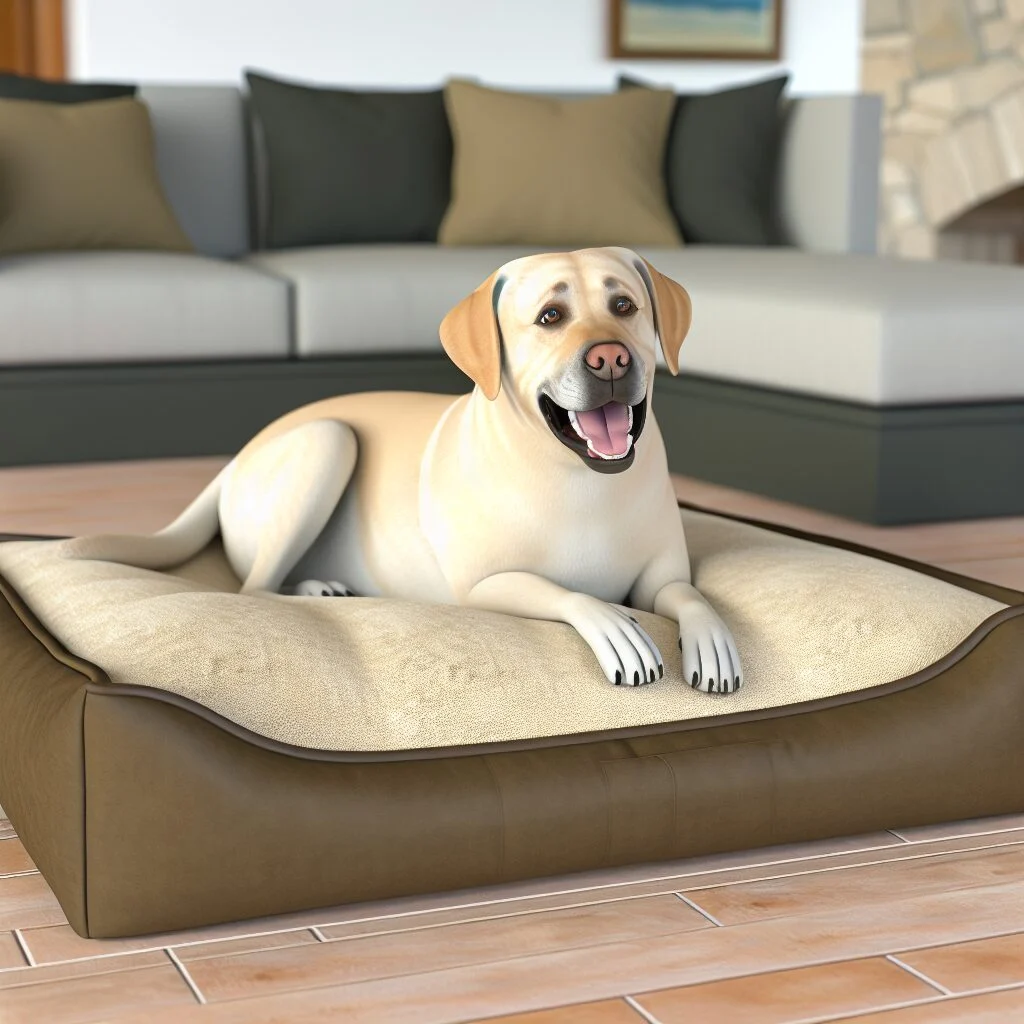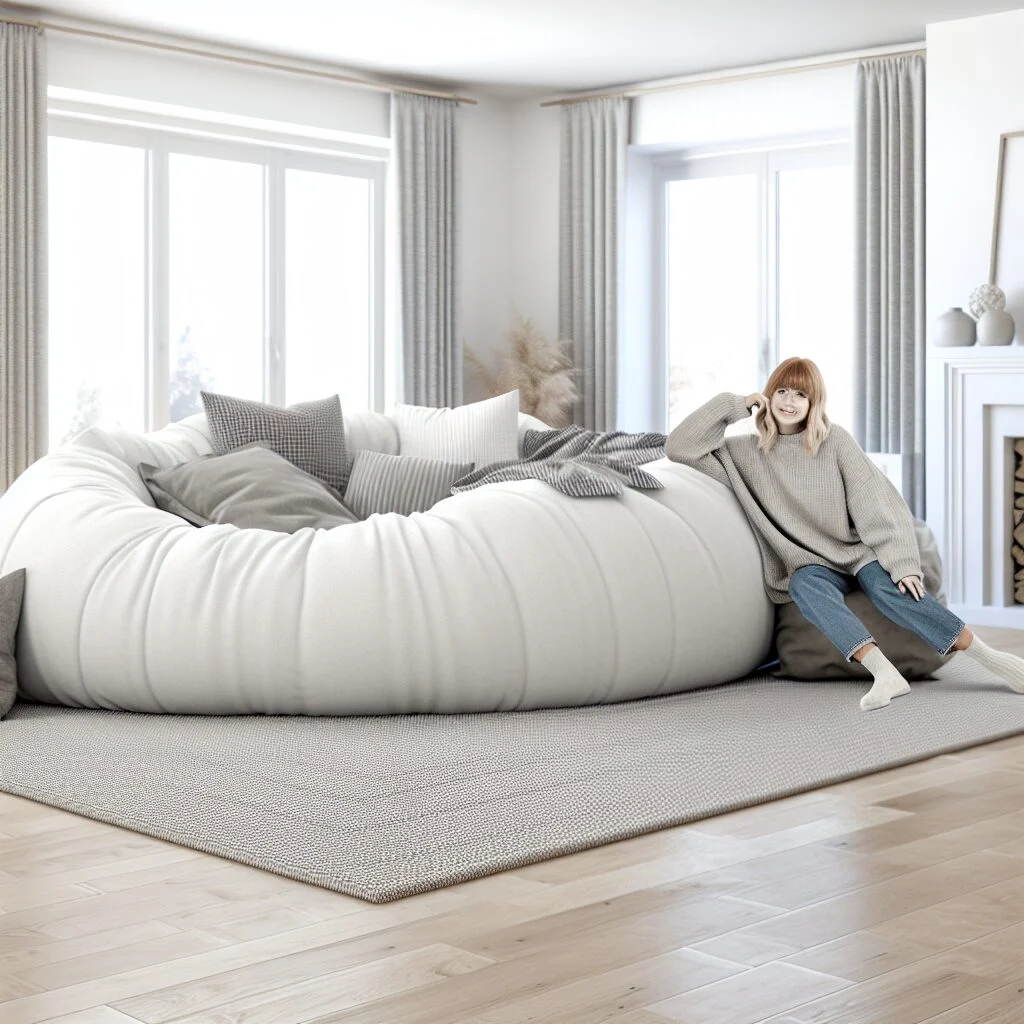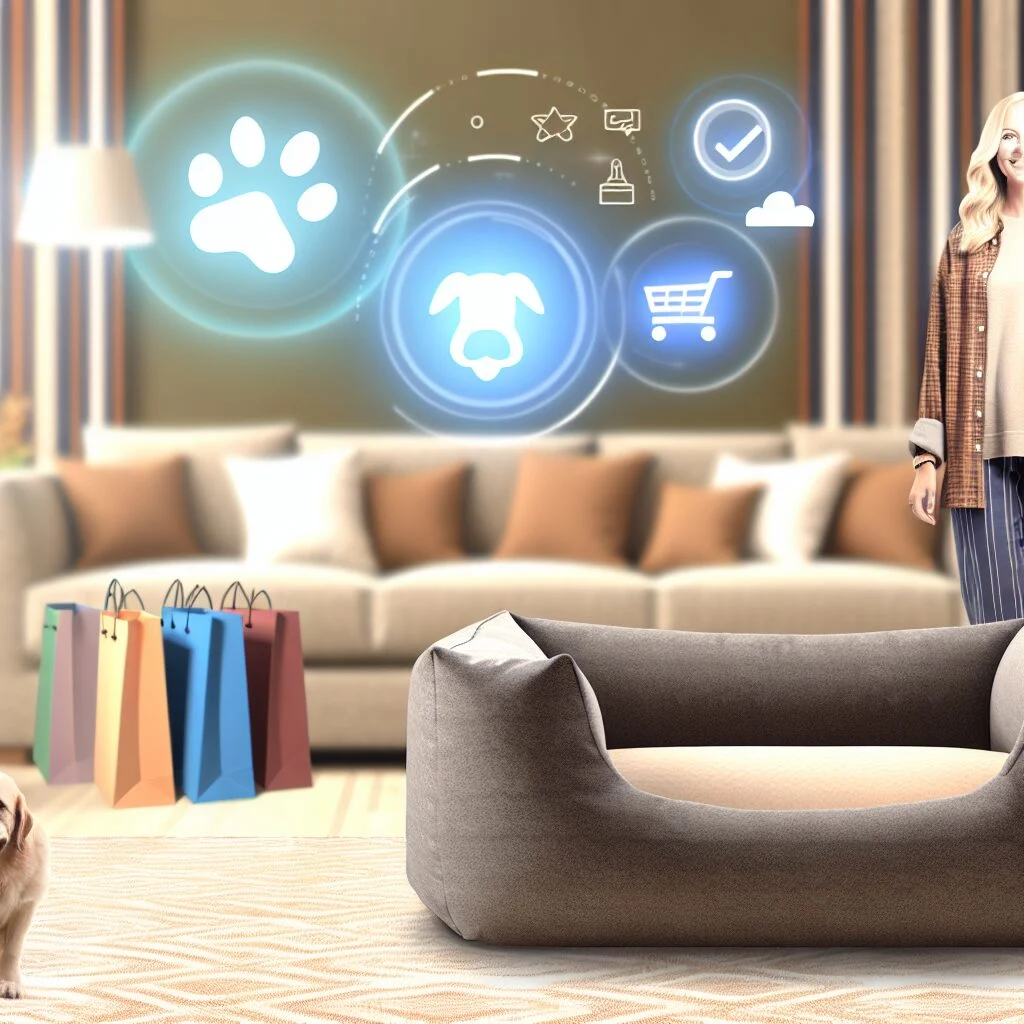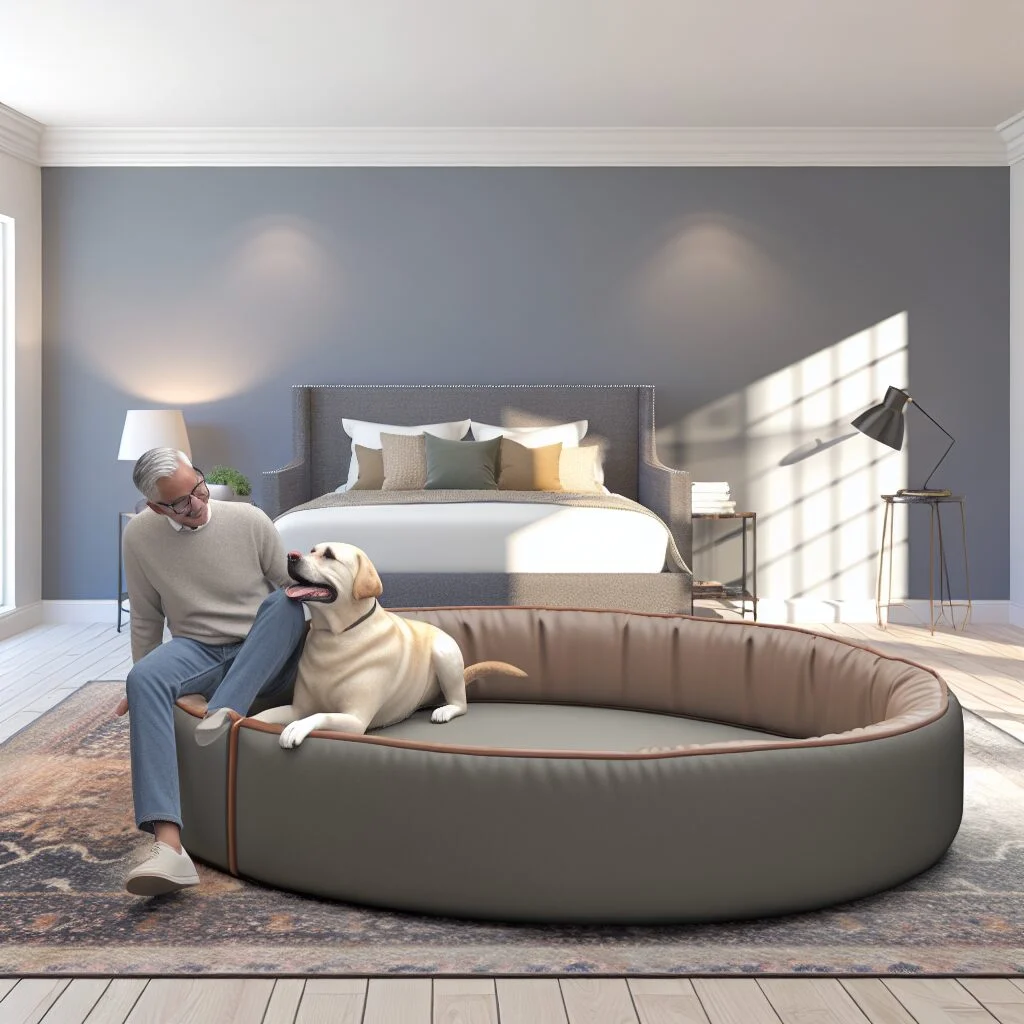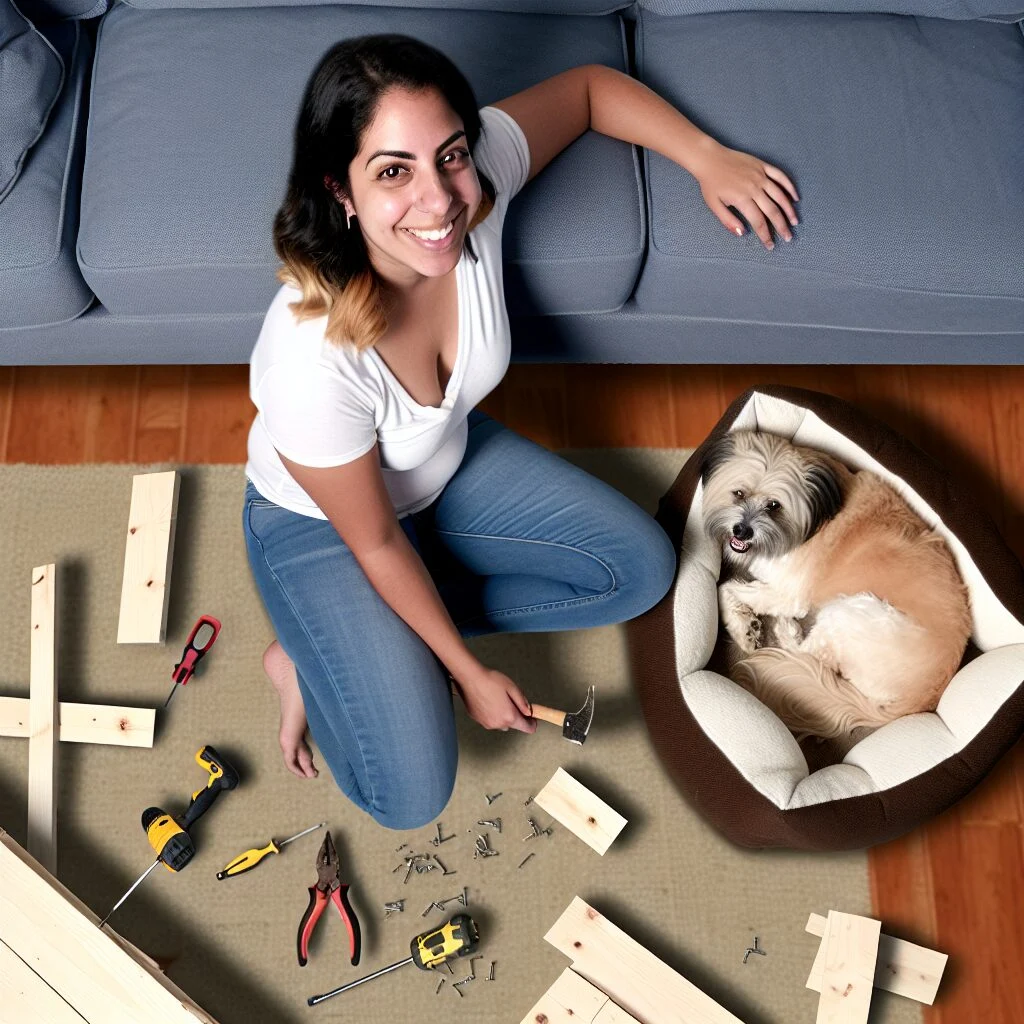The Ultimate Guide to Human Dog Beds on Amazon: Comfort, Reviews, and Shopping Tips
Have you ever watched your furry companion curled up in their plush dog bed and felt a twinge of envy? The way they sink into that soft, cushiony donut shape, looking utterly content and comfortable—it’s enough to make any pet owner wonder if they’re missing out. Well, wonder no more. The human dog bed revolution has arrived, and it’s transforming how we think about relaxation, comfort, and the bond we share with our pets.
Human dog beds—essentially oversized versions of the classic donut-shaped pet beds but designed for people—have surged in popularity over the past few years. These innovative comfort solutions offer a unique lounging experience that traditional furniture simply can’t match. And the best part? They’re readily available on Amazon, making it easier than ever to bring this cozy experience into your own home.
In this comprehensive guide, we’ll explore everything you need to know about human dog beds: their benefits, the top models available on Amazon, important features to consider before purchasing, real customer reviews, and even how to build your own. Whether you’re looking for a comfortable spot for Netflix marathons, a cozy napping nook, or a unique way to bond with your pet, a human dog bed might be exactly what you’ve been looking for.
What Exactly Is a Human Dog Bed?
A human dog bed is exactly what it sounds like—a dog bed designed for human use. These oversized, plush loungers typically feature the same donut or bolster design as traditional dog beds but scaled up to accommodate adult humans. The most popular models, like the pioneering Plufl, feature 360-degree plush pillow bolsters that create a sense of security and comfort that both pets and people find irresistible.
These beds aren’t just novelty items; they’re thoughtfully designed comfort solutions built with high-quality materials including memory foam bases, orthopedic supports, and super-soft, washable covers. The raised edges provide support for your head, back, and knees, allowing you to curl up in various positions while feeling gently cradled from all sides.
Human dog beds serve multiple purposes in the home. They’re perfect for:
- Casual lounging while reading or watching TV
- Power naps and meditation sessions
- Cozy spaces to bond with your pet
- Alternative seating for apartments or small spaces
- Sensory-friendly relaxation spots for those with anxiety or sensory processing sensitivity
The beauty of these beds is that they create a versatile, informal lounging space that fills the gap between traditional furniture like couches and beds. Their portable nature means they can be moved from room to room, adapting to your comfort needs throughout the day.
The Plufl: Pioneer of Human Dog Beds on Amazon
When discussing human dog beds, it’s impossible not to highlight the Plufl—the self-proclaimed “world’s first dog bed for humans” and the brand that essentially created this product category. Available on Amazon for approximately $300 (or directly through their website for $275), the Plufl has become the gold standard in human dog beds.
The Plufl measures 68 inches long by 33 inches wide, making it spacious enough for most adults to curl up comfortably. It features a thick memory foam base covered with a plush, faux fur cover that’s soft to the touch and machine washable. The orthopedic design provides exceptional support, particularly for those with back or joint pain who find traditional furniture insufficient for their comfort needs.
What sets the Plufl apart is the attention to detail in its design. The bolster edges are firm enough to provide meaningful support but soft enough to nestle against comfortably. The depth of the bed creates a gentle cradling effect that many users describe as “womb-like” or reminiscent of being hugged. This design isn’t just comfortable—it can actually trigger a sense of security that many find helps reduce anxiety and promote relaxation.
Customer reviews consistently praise the Plufl for its exceptional comfort and quality materials. Many reviewers note that both they and their pets fight over who gets to use it, with some families ultimately purchasing multiple units to maintain household harmony. The company’s customer service also receives high marks, with several reviews mentioning how attentive the company was after delivery issues or other concerns.
Other Top Human Dog Beds Available on Amazon
While the Plufl may have pioneered the category, Amazon now offers several alternatives at various price points and with different features. Here’s a rundown of some other top contenders in the human dog bed market:
MIULEE Large Human Dog Bed
The MIULEE bed measures an impressive 71 inches by 45 inches, making it one of the larger options available. At around $150-200, it’s more budget-friendly than the Plufl while still offering quality construction. The washable faux fur cover comes in multiple color options, and customers particularly praise its plushness and the included blanket and pillow accessories.
HACHIKITTY Oversized Pet Bed for Humans
This orthopedic option features a non-slip bottom and waterproof inner lining, making it ideal for households with pets who might have accidents. The removable cover is machine washable, and at around $120-170, it represents a good mid-range option with practical features for pet owners.
PUPPBUDD Jumbo Pet Sofa Bed
While slightly smaller than some other options at 55 inches, this model offers excellent value at around $90-120. Its more compact size makes it suitable for apartments or smaller rooms while still comfortably accommodating most adults in a curled position. The memory foam construction receives particular praise for providing good support.
EMME Premium Human Dog Bed with Cooling Gel Memory Foam
For those who tend to sleep hot, this cooling gel-infused option provides temperature regulation alongside comfort. At approximately $220-280, it’s a premium option, but the cooling technology makes it stand out for many users who find other foam beds too warm.
When comparing these options, consider not just price but dimensions, materials, and special features that might address your specific needs. Most models offer removable, washable covers—an essential feature given that these beds often become favorite lounging spots for both humans and pets.
Key Features to Consider When Shopping for a Human Dog Bed on Amazon
With the growing popularity of human dog beds, manufacturers are adding various features to differentiate their products. Here are the most important factors to consider before making your purchase:
Size and Dimensions
Human dog beds typically range from 55 to 75 inches in length and 30 to 45 inches in width. Your height and preferred sleeping/lounging position should guide your choice. If you’re taller than 5’10” or prefer to stretch out rather than curl up, look for beds on the larger end of the spectrum. Some manufacturers provide diagrams showing how different-sized people fit in their beds—these can be helpful reference points.
Material Quality and Comfort
The filling and cover materials significantly impact comfort, durability, and maintenance:
- Filling: Memory foam provides the best support but retains heat. Some beds combine memory foam with cooling gel or other materials to regulate temperature. Polyester fiber fills are lighter and often less expensive but may compress over time.
- Cover: Faux fur is popular for its softness, but microfiber, velvet, and cotton blends are also common. Consider your climate and whether you run hot or cold when selecting a cover material.
- Bolsters: The firmness of the surrounding bolsters affects how supportive the bed feels. Some people prefer firmer bolsters for better back support, while others favor softer ones for a cushier feel.
Maintenance and Cleaning
Since these beds will likely be used by both humans and pets, ease of cleaning is crucial:
- Look for removable, machine-washable covers
- Check if the inner lining is waterproof (especially important for households with pets)
- Consider darker colors or patterns that hide dirt and pet hair better
- Some premium models feature anti-microbial treatments that help reduce odors
Portability and Storage
While these beds are meant to be semi-permanent fixtures in your home, consider:
- Weight (ranges from 10 to 25+ pounds)
- Whether the bed has handles for repositioning
- If the bed can be compressed for storage when not in use
- Some models come with storage bags for travel or seasonal storage
Price and Value
Human dog beds on Amazon range from approximately $90 to $350. Higher-priced models typically offer better materials, longer warranties, and more specialized features like cooling technology or orthopedic support. Consider how frequently you’ll use the bed and whether special features justify the higher price point for your situation.
Real User Experiences: What Amazon Customers Say About Human Dog Beds
Customer reviews provide valuable insights into how these beds perform in real-world settings. Here’s what Amazon purchasers consistently say about their human dog bed experiences:
Positive Feedback Themes
The most common positive comments focus on comfort and versatility. Many users report that their human dog beds have become the most sought-after spot in the house, with multiple family members (and pets) competing for time in them. Specific benefits mentioned include:
- Anxiety and stress relief: Many users, particularly those with anxiety disorders, ADHD, or sensory processing issues, report that the gentle pressure from the bolsters creates a calming effect similar to weighted blankets.
- Sleep quality improvement: While not designed as primary sleeping surfaces, many users find that napping in these beds results in deeper, more restorative rest than on conventional furniture.
- Pain reduction: Users with chronic pain conditions frequently mention relief when lounging in these beds, citing the supportive nature of the design that cradles the body from multiple angles.
- Pet bonding: The shared experience of enjoying the same type of lounging space creates a unique bonding opportunity with pets, with many users sharing photos of themselves cuddled up with their dogs or cats in these beds.
One particularly compelling review noted: “I was skeptical about spending this much on what is essentially a giant dog bed, but after dealing with anxiety-related insomnia for years, this has become my go-to relaxation spot. Something about curling up in this shape with the gentle pressure from all sides helps my mind quiet down. Best purchase I’ve made for my mental health in years.”
Critical Feedback to Consider
Common criticisms in reviews include:
- Heat retention: Memory foam models, in particular, can get uncomfortably warm for extended lounging, especially in warmer climates.
- Sizing misconceptions: Some users expect to be able to fully stretch out but find the beds only comfortable in a curled or semi-fetal position.
- Durability concerns: Lower-priced models sometimes show premature compression of the filling or seam failures, particularly with heavier users.
- Cover texture preferences: The plush faux fur coverings, while popular with most, can feel too warm or textually overwhelming for some sensory-sensitive individuals.
One balanced review stated: “I love the concept and comfort of my human dog bed, but I wish manufacturers would offer more cover material options. The faux fur is beautiful but impractical for our hot climate. I ended up sewing a cotton blend cover which solved the problem, but it would be nice if these came with seasonal cover options.”
DIY Human Dog Beds: Building Your Own Custom Creation
If you’re feeling creative or budget-conscious, building your own human dog bed can be a rewarding project. The DIY approach allows for complete customization of size, materials, and aesthetics while potentially saving money compared to premium retail options. Here’s a simplified approach to creating your own human dog bed:
Materials You’ll Need
- Upholstery foam (4-6 inches thick for the base)
- Pool noodles or firm foam tubing for bolsters
- Batting or soft foam topper for comfort
- Upholstery fabric or washable covers (approximately 5-7 yards depending on size)
- Heavy-duty thread and sewing machine (or fabric glue for no-sew options)
- Measuring tape and scissors
- Optional: waterproof liner material
Step-by-Step Building Process
- Design and measure: Decide on your dimensions based on your height and available space. Most adult-sized beds should be at least 60 inches long and 30 inches wide for the base.
- Create the base: Cut upholstery foam to your desired size. For enhanced comfort, consider layering different densities with softer foam on top.
- Form the bolsters: Shape flexible foam tubes into a continuous ring or U-shape to create the raised edges. Pool noodles can work for budget builds, though purpose-made upholstery foam yields better results.
- Attach bolsters to base: Secure the bolster ring to the base using fabric glue, heavy-duty stitching, or by designing a cover that holds everything in position.
- Create a removable cover: Design a zippered cover with separate compartments for the base and bolsters to allow for washing. Consider adding a waterproof liner if pets will be using the bed.
- Add finishing touches: Consider including straps for portability, extra pillows for customizable support, or a matching throw blanket.
The DIY approach typically costs between $100-200 in materials, representing significant savings over premium retail models. However, the investment in time and potential learning curve for sewing skills should be considered. Many DIY enthusiasts find that the customization possibilities make the effort worthwhile—you can match your home decor perfectly or create specialized features that commercial models don’t offer.
One creative DIY builder shared: “I made my human dog bed with a removable cooling gel layer for summer and a heated pad option for winter. No commercial bed offered this dual-season functionality, but my homemade version cost less than $150 in materials and perfectly suits our climate needs.”
Dog Beds Attached to Human Beds: A Different Approach to Pet Sharing
If you’re interested in the concept of shared relaxation space with your pet but aren’t ready to commit to a full human dog bed, another popular option has emerged on Amazon: dog beds specifically designed to attach to your existing human bed.
These clever accessories create a dedicated pet space that connects directly to your mattress, offering several advantages:
- Space efficiency: Ideal for smaller living spaces where a separate human dog bed might not fit
- Proximity without sharing: Allows your pet to sleep next to you without taking up mattress space
- Security for pets: Provides your pet with a sense of security from being close to you
- Cleanliness: Keeps pet hair contained to their area rather than spreading across your bedding
Popular models on Amazon include the ZAOWU Cat Hammock Bed, which creates a suspended sleeping platform alongside your bed, and the PETIQUE Bedside Lounge Pet Bed, which attaches to your bed frame at mattress level. These typically range from $40-120 depending on size and features.
One satisfied customer explained: “My dog always tried to sleep in my bed, but her fur triggered my allergies. The attached dog bed has been the perfect compromise—she’s right next to me, feeling secure and connected, but her fur stays in her own space. She actually prefers it to being on the mattress now!”
When selecting an attached bed, consider your pet’s size and sleeping preferences, your bed frame construction, and whether you need the attachment to be permanent or removable. Most models work best with platform beds or frames that have visible side rails for attachment.
The Psychology Behind Human Dog Beds: Why Are They So Comforting?
The extraordinary comfort that many people report from human dog beds isn’t just about physical support—psychological factors play a significant role in why these products have developed such devoted followers.
The Science of Comfort and Security
Human dog beds tap into several psychological comfort mechanisms:
- Deep pressure stimulation: The gentle, surrounding pressure from bolsters triggers the same calming response as weighted blankets or hugs, potentially increasing serotonin and reducing cortisol levels.
- Regression comfort: The curled position these beds encourage mimics fetal positioning, which many people unconsciously associate with security and comfort.
- Defined boundaries: The clear physical boundaries of the bed create a psychological sense of defined space that can reduce anxiety, especially in open-concept living environments.
- Primitive nest association: Evolutionary psychologists suggest humans may retain instinctive comfort associations with nest-like environments that provided safety for our ancestors.
Dr. Ellen Vora, a holistic psychiatrist, has noted that “environments that create gentle containment without confinement can provide significant anxiety relief for many people. The human dog bed design essentially creates a microenvironment that signals safety to our nervous system.”
Benefits for Specific Conditions
Reviews and testimonials frequently mention specific benefits for various conditions:
- Anxiety disorders: Users report reduced anxiety symptoms when relaxing in these beds
- Autism spectrum and sensory processing: The defined space and consistent pressure can help with sensory regulation
- ADHD: The gentle containment may help reduce restlessness and support focus during quiet activities
- Insomnia: The unique sleep position and comfort may help with sleep initiation for some individuals
While not medical devices, these beds appear to provide meaningful comfort for many people dealing with these conditions. The emerging popularity of human dog beds reflects a broader trend toward creating comfort solutions that address both physical and psychological needs, rather than just traditional furniture aesthetics.
Styling and Incorporating a Human Dog Bed into Your Home Decor
One common hesitation about purchasing a human dog bed is concern about how such an unconventional piece will fit into existing home decor. However, with thoughtful placement and styling, these comfort pods can become attractive focal points rather than eyesores.
Ideal Placement Options
- Living room reading nook: Position near natural light with a small side table for books and beverages
- Home office retreat: Create a comfort zone for breaks that promotes quick mental reset
- Bedroom relaxation corner: Perfect for winding down before transitioning to sleep
- Media room lounging: Ideal for casual movie watching or gaming sessions
- Sunroom or enclosed porch: Create an indoor/outdoor relaxation space
Styling Tips to Integrate with Your Decor
To help your human dog bed complement rather than clash with your existing aesthetic:
- Choose coordinating colors: Select cover colors that complement your existing color scheme rather than match it exactly—this helps the bed feel intentional rather than matchy-matchy
- Add proper accessorizing: Style with throw pillows and blankets in complementary textures and patterns
- Consider surrounding furniture scale: Pair with lower profile furniture to create balanced visual weight in the room
- Incorporate with purpose: Position near bookshelves, plants, or lighting to create a deliberate relaxation station
- Use room dividers or screens: In open concept spaces, use decorative screens to create a semi-private relaxation zone
Interior designer Melissa Wagner suggests: “Think of human dog beds as you would a statement chair or chaise lounge—they’re conversation pieces that serve a functional purpose. By integrating them meaningfully with adjacent decor elements and ensuring proper scale relationship with nearby furniture, they can enhance rather than detract from your overall design scheme.”
Some innovative users have even incorporated built-in solutions, creating alcoves or window seats specifically sized for their human dog beds, effectively transforming them from standalone objects to architectural features. This approach works particularly well in small spaces or rooms with unusual layouts where conventional furniture placement is challenging.
Maintenance and Care Tips for Your Human Dog Bed
To ensure your human dog bed remains a clean, comfortable retreat for years to come, proper maintenance is essential. These beds represent a significant investment, and with proper care, most quality models should last 3-5 years or longer.
Regular Cleaning Routine
- Weekly maintenance: Vacuum the surface using an upholstery attachment to remove hair, dust, and dander
- Bi-weekly refresh: Spot clean any small stains using appropriate cleaners for your cover material
- Monthly deep clean: Remove and wash covers according to manufacturer instructions (most are machine washable on gentle cycles)
- Quarterly refresh: Air out the foam base and bolsters outdoors on a dry, sunny day to prevent odors
Addressing Common Issues
Even with careful use, you may encounter these common problems:
- Flattened filling: Most foam will naturally compress with use. Regularly rotate the bed and manually fluff bolsters to maintain shape. For polyester-filled models, a trip through the dryer with tennis balls can help restore loft.
- Stubborn odors: For persistent smells, sprinkle baking soda liberally over the bed, let sit overnight, then vacuum thoroughly. Enzymatic pet odor eliminators are also effective for beds shared with animals.
- Cover wear: If the original cover wears out before the foam, many manufacturers sell replacement covers separately. Alternatively, consider having a custom cover made by an upholstery shop.
- Zippers and seams: Address any small tears or failing zippers promptly to prevent larger structural issues. Most fabric stores can make minor repairs inexpensively.
Extending Lifespan
To maximize your investment:
- Consider using a waterproof liner between the foam and the decorative cover
- Keep the bed out of direct sunlight, which can degrade foam and fade fabric
- Rotate usage areas to distribute wear evenly
- For beds frequently shared with pets, consider a secondary, easily washable throw blanket as a first layer
One resourceful owner shared: “I invested in two different covers for our human dog bed—a cozy, plush winter cover and a lighter cotton blend for summer. This not only helps manage temperature comfort but also extends the life of each cover since they’re used seasonally rather than year-round.”
Value Assessment: Are Human Dog Beds Worth the Investment?
With prices ranging from under $100 for basic models to over $300 for premium options, human dog beds represent a significant purchase for most consumers. Are they worth the investment? The answer depends on your specific needs, usage patterns, and what you value in your relaxation furniture.
Cost-Benefit Analysis
Consider these factors when evaluating value:
- Cost per use: A $300 bed used daily for 3 years equals about 27 cents per day—comparable to many subscription services
- Multi-user value: Beds used by multiple family members and pets offer greater utility per dollar
- Therapeutic benefits: If the bed provides anxiety relief or comfort that reduces other treatment needs, the value increases substantially
- Space efficiency: These beds often replace multiple furniture pieces (floor pillows, pet beds, casual seating) potentially offering net space and cost savings
Who Benefits Most?
Human dog beds tend to provide greatest value for:
- Pet owners seeking to strengthen bonds with their animals
- Individuals with anxiety, sensory processing differences, or chronic pain
- Small space dwellers needing flexible, multi-purpose furniture
- Families looking for casual, shareable lounging options
They may be less valuable for:
- Those who rarely spend time lounging or relaxing at home
- Individuals who strongly prefer conventional sitting/reclining positions
- People with mobility issues that make ground-level seating difficult
One pragmatic reviewer noted: “I initially balked at spending $250 on what’s essentially a glorified cushion, but after calculating what I spent annually on massage therapy for my chronic back pain, I realized even modest relief from this bed would pay for itself quickly. After six months, I can say it was absolutely worth every penny—my massage visits have decreased by half.”
Investment Protection
To ensure you get maximum value:
- Check warranty terms before purchasing (quality brands offer 1-3 year coverage)
- Verify return policies, as these bulky items can be expensive to ship back
- Consider models with replaceable components (especially covers) to extend useful life
- Read the fine print on care instructions to avoid actions that might void warranty protections
The Verdict on Value
For most users who appreciate their unique comfort benefits, human dog beds prove to be worthwhile investments that provide daily value through improved relaxation, reduced stress, and enhanced pet bonding opportunities. The key is matching your selection to your specific needs and ensuring you’re investing in quality that will stand up to your intended use patterns.
Conclusion: Is a Human Dog Bed Right for You?
Human dog beds represent a fascinating evolution in home comfort furniture—blending the boundary between pet accessories and human relaxation solutions in a way that speaks to our desire for cozy, casual comfort and closer connections with our animal companions.
These innovative products fill a unique niche in our homes: more structured than floor pillows, more versatile than traditional furniture, and more sharable than conventional pet beds. They create opportunities for new relaxation postures and experiences that mainstream furniture often doesn’t address.
As we’ve explored throughout this guide, the right human dog bed can provide extraordinary comfort, potential therapeutic benefits, and a novel way to bond with pets. While not for everyone, their growing popularity suggests they’re meeting genuine needs for many households.
When deciding if a human dog bed deserves a place in your home, consider not just the practical aspects of space, budget, and maintenance, but also the less tangible benefits—the daily moments of comfort, the potential stress reduction, and the unique joy that comes from curling up in a space that feels instinctively secure and soothing.
Whether you choose a premium model from Amazon like the pioneering Plufl, explore more budget-friendly alternatives, or embark on a DIY project to create a custom solution, the human dog bed represents a charming reminder that sometimes the most unexpected innovations can bring significant comfort to our daily lives.
After all, perhaps our canine companions have been onto something all along with their donut beds and nesting behaviors. Sometimes the best way to relax is to curl up in a soft, supportive space that gently hugs you back—a simple pleasure that both humans and dogs can appreciate equally.
Frequently Asked Questions About Human Dog Beds on Amazon
What exactly is a human dog bed?
A human dog bed is an oversized version of a traditional donut-shaped dog bed designed specifically for human use. Typically measuring between 55-75 inches long and 30-45 inches wide, these beds feature plush cushioning and raised, supportive bolsters around the edges. The most popular model, the Plufl, markets itself as the “world’s first dog bed for humans” and features 360-degree pillow bolsters that provide exceptional comfort for lounging, napping, and relaxation.
How much do human dog beds cost on Amazon?
Human dog beds on Amazon range in price from approximately $90 for basic models to $350 for premium options. The pioneering Plufl human dog bed costs around $300 on Amazon (or $275 directly from the manufacturer’s website). Mid-range alternatives like the MIULEE Large Human Dog Bed typically cost between $150-200. Price differences generally reflect variations in size, materials quality, special features (like cooling gel or orthopedic support), and brand recognition.
Are human dog beds worth the investment?
For many users, human dog beds provide significant value through daily comfort, anxiety reduction, and enhanced pet bonding opportunities. When calculating cost per use, a $300 bed used daily for 3 years equals about 27 cents per day. These beds offer particular value for people with anxiety or sensory processing differences, pet owners seeking shared relaxation space with their animals, and those living in small spaces who need versatile furniture. Most quality models last 3-5 years with proper care, making them comparable in longevity to other furniture investments.
How do I clean and maintain a human dog bed?
Most human dog beds feature removable, machine-washable covers that should be laundered monthly on gentle cycles. Weekly vacuuming with an upholstery attachment helps remove hair and dander, while quarterly airing out of foam components prevents odor buildup. For beds frequently shared with pets, consider using a waterproof liner between the foam and decorative cover and adding an easily washable throw blanket as a first layer. Address any small tears or failing zippers promptly to prevent larger structural issues, and rotate the bed regularly to maintain even wear patterns.
Can I build my own human dog bed instead of buying one?
Yes, building your own human dog bed is a viable option that typically costs $100-200 in materials, representing significant savings over premium retail models. The DIY approach requires upholstery foam (4-6 inches thick for the base), firm foam tubing for bolsters, batting for comfort, upholstery fabric, and basic sewing supplies. The process involves creating a foam base, shaping bolsters, securing components together, and crafting a removable, washable cover. While requiring time and basic crafting skills, DIY construction allows complete customization of size, materials, and aesthetics to perfectly match your needs and home decor.
What alternatives exist if I’m interested in sharing relaxation space with my pet?
If you’re not ready to commit to a full human dog bed, consider dog beds that attach to your existing human bed. Products like the ZAOWU Cat Hammock Bed and PETIQUE Bedside Lounge Pet Bed create dedicated pet spaces that connect directly to your mattress or bed frame. These attachable options typically cost between $40-120 depending on size and features. They provide the proximity of sleeping near your pet without sharing mattress space, help contain pet hair to a dedicated area, and are ideal for smaller living spaces where a separate human dog bed might not fit.
| Human Dog Bed Model | Approximate Price | Dimensions | Key Features |
|---|---|---|---|
| Plufl Human Dog Bed | $300 (Amazon) / $275 (Direct) | 68″ × 33″ | Memory foam base, orthopedic design, machine-washable faux fur cover |
| MIULEE Large Human Dog Bed | $150-200 | 71″ × 45″ | Includes matching blanket and pillow, multiple color options |
| HACHIKITTY Oversized Pet Bed | $120-170 | 65″ × 40″ | Non-slip bottom, waterproof inner lining, removable cover |
| PUPPBUDD Jumbo Pet Sofa Bed | $90-120 | 55″ × 35″ | Compact size for smaller spaces, memory foam construction |
| EMME Premium Human Dog Bed | $220-280 | 70″ × 43″ | Cooling gel memory foam, temperature regulation technology |
Information sources: Better Homes & Gardens, Reader’s Digest, and Amazon product listings as of 2023.
